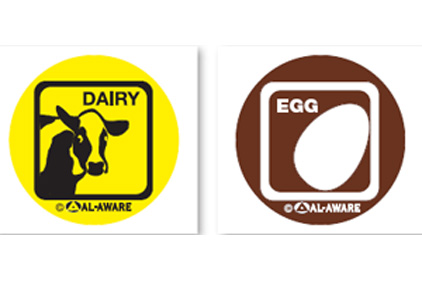Food Safety
Using color to ensure food safety
Colors can help minimize cross-contamination or adulteration and ensure procedures are followed.

One of the best tools for helping workers and managers stay on the path to food safety is color to designate what must be done in an operation. And one of the best applications of color is in allergen management and control.
Many processors have developed programs where allergens are flagged the moment they arrive on the loading dock. Pallets and/or individual bags, totes, pails or cases are tagged by the receiving crew with distinctly colored allergen tags. Other processors have taken this a step further by utilizing distinct colors for each allergen received.

|
| Al-Aware has developed a series of allergen tags that can be used not only for products in the warehouse, but also work-in-process and process records. Source: Al-Aware. |
Al-Aware has developed a series of allergen tags that can be used not only for products in the warehouse, but also work-in-process and process records. The company manufactures two kinds of tags: small dots about the size of a half dollar and tags that are bumper sticker-sized. The former may be used on records or cases; the latter can be used to designate storage areas. What makes these tags unique is that each allergen is assigned a different color. In addition, each tag includes an icon and a description. For instance, the sticker for milk is yellow, has a picture of a cow and says “Dairy Allergen.” This kind of presentation helps address issues such as literacy and color blindness. (See images below.)
Color also can be used in other parts of processors’ allergen control programs. Many operations mandate that allergens of each type be handled using different-colored pails, totes or scoops. For example, a processor might use yellow for wheat, red for soy, green for almonds and white for dairy. The scoops are constructed from plastic or stainless steel. However, plastic scoops wear over time and may shed into the product, so processors using plastic scoops must train staff to monitor the condition of utensils, and when a scoop begins to wear, it must be taken out of service.
Other processors use stainless steel scoops with different-colored handles. These are more expensive, but have greater durability. However, many foods and ingredients may contain more than one allergen, so any processor that uses designated colors should consider this issue.
Colors are also used to designate how products are handled and disposed. A plant might use black or gray drums or barrels for non-food waste, red for organic waste and white for ingredients or work-in-process. When colors are used this way, the color schemes should be posted around the plant, workers must be trained to adhere to the color schemes, and managers need to be trained to monitor worker performance.
Another excellent use for color is in plants that handle raw and cooked products that must be kept segregated. Workers on the raw side might don white uniforms while those on the cooked side wear another color such as blue or red. A well-run operation will establish changing rooms for uniforms, boots, hair restraints, caps or bump caps to minimize the potential of cross-contamination.
Plants also may use the colors of employee apparel to define duties or roles. In these cases, maintenance personnel almost always wear uniforms that differ in color from those of line workers and managers. Some facilities use colored hats, bump caps or uniforms to designate members of the safety team, quality control, visitors or first responders.
Color-coded plumbing systems help ensure both food and worker safety. Plant lines for steam, water, hot water, compressed air and CIP are labeled in an easily understood way. For example, lines conveying steam or hot water might be flagged with hot colors such as red or orange, whereas water lines might use blue or green.
When building a food safety (or worker safety) program, think about incorporating color into it. Colors are very distinctive, can help minimize cross-contamination or adulteration and ensure procedures are followed. But a color system isn’t all you need; you must train all employees on the color schemes and ensure they adhere to color mandates.
Looking for a reprint of this article?
From high-res PDFs to custom plaques, order your copy today!









